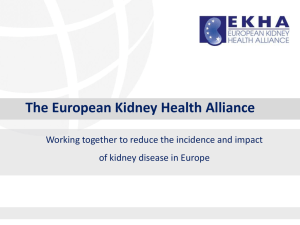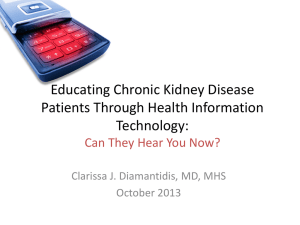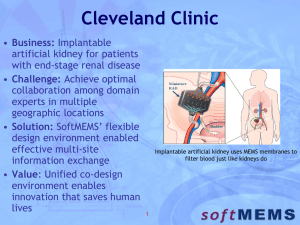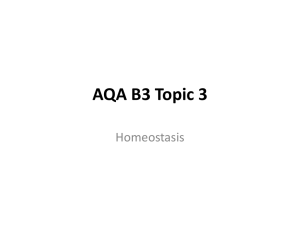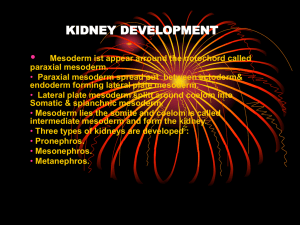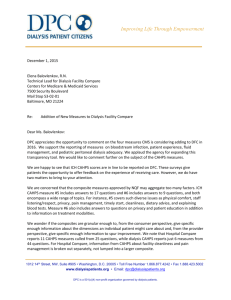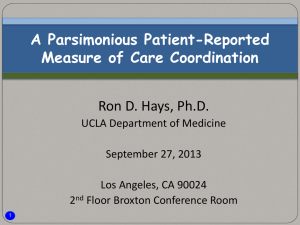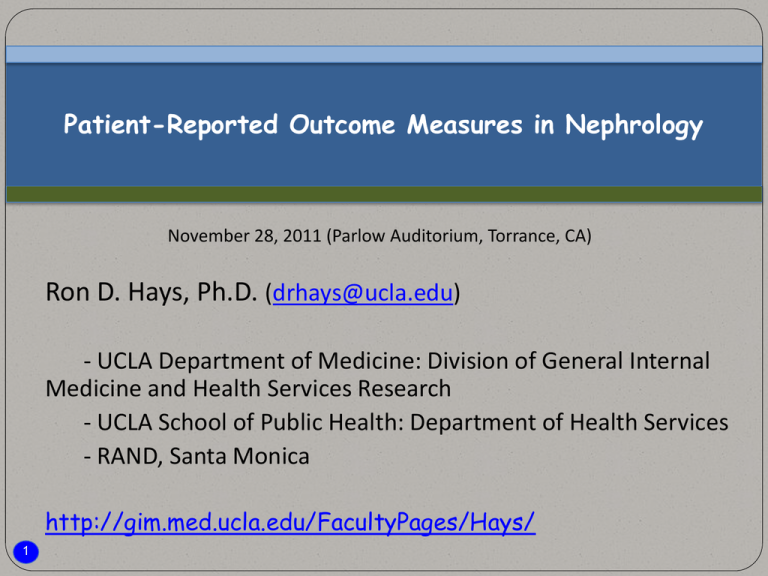
Patient-Reported Outcome Measures in Nephrology
November 28, 2011 (Parlow Auditorium, Torrance, CA)
Ron D. Hays, Ph.D. (drhays@ucla.edu)
- UCLA Department of Medicine: Division of General Internal
Medicine and Health Services Research
- UCLA School of Public Health: Department of Health Services
- RAND, Santa Monica
http://gim.med.ucla.edu/FacultyPages/Hays/
1
Outline of Presentation
• Patient-reported measures figure
• Consumer Assessment of Healthcare
Providers and Systems (CAHPS®)
• Kidney Disease Quality of Life measure
– KDQOLTM-36
2
Patient-Reported Measures
Technical
Demographics
Reports
Quality
of Care
Behavior
Health
Clinical
3
Reports
4
Consumer Assessment of Healthcare
Providers and Systems
(CAHPS®) Surveys
• Ambulatory Care Surveys
–
–
–
–
–
–
–
CAHPS Health Plan Survey
CAHPS Clinician & Group Survey
CAHPS Surgical Care Survey
ECHO® Survey
CAHPS Dental Plan Survey
CAHPS American Indian Survey
CAHPS Home Health Care Survey
• Facility Surveys
– CAHPS Hospital Survey
– CAHPS Nursing Home Survey
– CAHPS In-Center Hemodialysis Survey
5
5
CAHPS Design Principles
• Emphasis on patients
– What patients value with respect to the setting of care
– Aspects of care for which patients are the best or only
source of information
• Dominated by reports rather than ratings of care
• Standardization
– Surveys, data collection, analysis, reporting,
benchmarking
• Many CAHPS surveys are NQF endorsed
• All CAHPS surveys and products are in the public domain
6
6
Development process
•
•
•
•
•
•
7
Literature review
Technical Expert Panels
Focus group feedback
Cognitive interviews (English and Spanish)
Field testing and psychometric analyses
Public release
7
CAHPS In-Center Hemodialysis
Survey (In the last 3 months …)
• How often did
– your kidney doctors listen carefully to you?
– your kidney doctors explain things in a way that was
easy to understand?
– your kidney doctors show respect for what you had
to say?
– your kidney doctors spend enough time with you?
– you feel your kidney doctors really cared about you
as a person?
Reporting Measures for the CAHPS® In-Center Hemodialysis Survey. Agency for Healthcare
Research and Quality, Rockville, MD. Updated Dec 2007.
https://www.cahps.ahrq.gov/cahpskit/files/509_ICH_Reporting_Measures.htm
8
8
Health-Related Quality of Life is …
What you can do.
• Functioning
Self-care
Role
Social
How you feel about your life.
• Well-being
Emotional well-being
Pain
Energy
9
HRQOL Framework
SelfReported
Health
Social
Support
10
Physical
Health
Physical Functioning
Mental
Health
Depressive
Symptoms
Social
Health
Ability to Participate
in Social Roles
Patient
Satisfaction
SF-36® Generic Profile Measure
• Functioning
– Physical functioning (10 items)
– Role limitations/physical (4 items)
– Role limitations/emotional (3 items)
– Social functioning (2 items)
•
Well-Being
– Emotional well-being (5 items)
– Energy/fatigue (4 items)
– Pain (2 items)
– General health perceptions (5 items)
11
11
Generic vs. Disease-Targeted
In general, would you say your health is:
Excellent/ Very good/ Good/ Fair/ Poor?
How much does kidney disease bother you
in your ability to work around the house?
Not at all bothered/Somewhat bothered/
Moderately bothered/Very much bothered/
Extremely bothered
12
12
Reliability of measures
0.0 (lowest) – 1.0 (highest possible)
̃ 0.80 for blood pressure and other clinical
measures
- 0.70-0.90 for multi-item self-report measures
Hahn, E. A., Cella, D., et al. (2007). Precision of health-related
quality-of-life data compared with other clinical measures.
Mayo Clin Proceedings, 82 (10), 1244-1254.
13
13
SF-36 Physical Health Component
Summary Score Predicts Mortality
18
17
16
14
% dead
5 yrs.
later
12
10
8
6
6
5
4
2
2
0
(n=676)
<35
(n=754)
35-44
(n=1181)
(n=609)
45-54
>55
SF-36 Physical Health Component Score (PCS)—T score
14
Ware et al. (1994). SF-36 Physical and Mental Health Summary Scales: A User’s Manual.
14
HRQOL Predicts Mortality and
Hospitalizations
• Kalantar-Zadeh et al. (2001, J Am Soc Nephrol)
– “Total score and MCS”
• Lowrie et al. (2003, Am J Kidney Dis)
– PCS and MCS
• Mapes et al. (2003, Kidney International)
– PCS, MCS, and Kidney Disease Component Score
(KDCS)
• Molnar-Varga et al. (2011, Am J Kidney Dis)
– PCS predictive of mortality
– MCS and Kidney Disease Quality of Life (KDQOLTM)
Symptom/problems predictive of transplant loss
15
Kidney Disease Quality of Life
(KDQOLTM) Instrument
Focus groups with patients and staff
Pretests on small samples
Field test with 165 persons with kidney
disease at 9 dialysis centers
Thousands of administrations since
16
17
18
Kidney Disease Quality of Life
(KDQOL) Publications
• Hays, R. D., Kallich, J. D., Mapes, D. L., Coons, S. J., & Carter, W.
B. (1994). Development of the Kidney Disease Quality of Life
(KDQOLTM) Instrument. Quality of Life Research, 3, 329-338.
• Edgell, E. T., Coons, S. J., Carter, W. B., Kallich, J. D., Mapes, D.,
Damush, T. M., & Hays, R. D. (1996). A review of health-related
quality of life assessment in end-stage renal disease. Clinical
Therapeutics, 18(5), 887-938.
• Rao, S., Carter, W. B., Mapes, D. L., Kallich, J. D., Kamberg, C. J.,
Spritzer, K. L., & Hays, R. D. (2000). Development of subscales
from the symptom/problems and effects of kidney-disease
items in the Kidney Disease Quality of Life (KDQOLTM)
instrument. Clinical Therapeutics, 22, 1099-1111.
19
KDQOL Targeted Domains
(97 items and 43 items)
Symptoms/problems
Effects of kidney disease
Burden of kidney disease
Work status
Cognitive function
Quality of social interaction
Sexual function
Sleep
Social support
Dialysis staff encouragement
Patient satisfaction
20
34 12
20
8
4
4
4
6
4
4
9
2
3
3
2
4
4
6
2
2
2
1
KDQOL-36
Items 1-12:
SF-12
Items 13-16: Burden of Kidney Disease (4)
Items 17-28: Symptoms/Problems (12)
Items 29-36: Effects of Kidney Disease (8)
Glover, C. et al. (2011). Understanding and assessing the
impact of end-stage renal disease on quality of life: A
systematic review of the content validity of selfadministered instruments used to assess health-related
quality of life in end-stage renal disease. Patient, 4(1),
19-30.
21
Burden of Kidney Disease
• My kidney disease interferes too much
with my life.
• Too much of my time is spent deading
with my kidney disease.
• I feel frustrated with my kidney
disease
• I feel like a burden on my family.
22
Symptom/Problems--
To what extent were you bothered by ...
•
•
•
•
•
•
•
•
•
•
•
•
23
Soreness in your muscles?
Chest pain?
Cramps?
Itchy skin?
Dry skin?
Shortness of breath?
Faintness or dizziness?
Lack of appetite?
Washed our or drained?
Numbness in hands or feet?
Nausea or upset stomach?
Problems with access (catheter) site?
Effects of Kidney Disease—
How much does kidney disease bother you in …
Fluid restrictions?
Dietary restriction?
Your ability to work around the house?
Your ability to travel?
Being dependent on doctors and other
medical staff?
• Stress or worries caused by kidney
disease?
• Your sex life?
• Your personal appearance?
•
•
•
•
•
24
Scoring
Higher score = better health
Transform linearly to 0-100 range
Average items in each scale together
25
KDQOL-36 Translations
Chinese
Czech
Danish
Dutch
English
French
German
Greek
Hebrew
Hungarian
Italian
Malay
Polish
Portuguese
Russian
Spanish
Swedish
Turkish
http://gim.med.ucla.edu/kdqol (register for downloads)
26
Dialysis Outcomes and Practice
Patterns Study (DOPPS)
• Longitudinal study of hemodialysis patients
and unit practices
– Goal is to identify practice patterns associated
with improved patient outcomes
• Uniform international data collection
–
–
–
–
Mortality
Health-related quality of life
Hospitalization
Vascular access
• Coordinated by Arbor Research
Collaborative for Health
27
DOPPS Data
• 308 dialysis facilities in DOPPS I
– 12,465 patients from 7 countries
– France, Germany, Italy, Japan, Spain, UK, US
• 320 dialysis facilities in DOPPS II
– 10,551 patients from 12 countries
– Same 7 above plus Australia, New Zealand,
Belgium, Canada and Sweden
• 297 facilities in DOPPS III
– 9,316 patients from the same 12 countries
28
Figure 1: Association of patient self-reported social support
and other psychosocial factors with all-cause mortality, by
region
29
KDQOLTM Scores Compared to
National Sample of Patients
80
Baseline
70
Follow-up
60
50
Symptom
40
Effects
30
Burden
20
10
0
DOPPS
30
Your Center
Your Center
Dialysis Outcomes and Practice Patterns
Study (DOPPS) 55-64 year old age group
31
Hemo. vs. Peritoneal Dialysis
90
80
70
60
50
HD
40
PD
30
20
10
0
Phy Func.
32
Pain
Effects
Burden
Work
Fructuoso et al. Quality of Life in chronic
kidney disease. Nefrologia, 2011, 31, 91-96.
Satisfaction
Future Directions
http://www.nihpromis.org/
• Item banks to assess HRQOL and allow for
computer-adaptive testing (CAT)
• Reliability = 1 – SE2 = 0.90
• SE = 3.2 for T-score (mean= 50 & SD = 10)
.
33
Anger CAT1 (In the past 7 days )
I was grouchy
– Never
– Rarely
– Sometimes
– Often
– Always
• Theta = 56.1 SE = 5.7
34
2In
the past 7 days …
I felt like I was read to explode
– Never
– Rarely
– Sometimes
– Often
– Always
• Theta = 51.9 SE = 4.8
35
3In
the past 7 days …
I felt angry
– Never
– Rarely
– Sometimes
– Often
– Always
• Theta = 50.5 SE = 3.9
36
4In
the past 7 days …
I felt angrier than I thought I should
– Never
– Rarely
– Sometimes
– Often
– Always
• Theta = 48.8 SE = 3.6
37
5In
the past 7 days …
I felt annoyed
– Never
– Rarely
– Sometimes
– Often
– Always
• Theta = 50.1 SE = 3.2
38
6In
the past 7 days …
I made myself angry about something just by
thinking about it.
–
–
–
–
–
Never
Rarely
Sometimes
Often
Always
• Theta = 50.2 SE = 2.8
39
Theta and SE estimates
•
•
•
•
•
•
40
Item 1: 56 and
Item 2: 52 and
Item 3: 50 and
Item 4: 49 and
Item 5: 50 and
Item 6: 50 and
6
5
4
4
3
<3
http://jwrginc.com/projects/current-projects
Functional Health Computer Adaptive Test (CAT) in Chronic Kidney
Disease
NIH Agency: The National Institute of Diabetes and Digestive and Kidney
Diseases (NIDDK)
Summary: This study completes a 4-year NIH-funded project designed to
evaluate improvements in CKD-specific impact measures used to estimate
health related quality of life outcomes among adult non-dialysis and nontransplant patients at Stages 3-5, dialysis patients, and transplant
patients. Previous phases (I and II) analyzed Internet-based survey data
to conduct psychometric tests of a new CKD-specific impact bank. Data
from this new clinic-based study are being analyzed to replicate prior
psychometric tests using Item Response Theory (IRT) as well as extend
the research to include clinical tests of discriminant validity and
responsiveness for new and legacy tools. JWRG and Tufts Medical Center
are supporting project completion out of their own research funds.
Investigators: JE Ware and K Meyer (Co-Investigators).
41
Thank you.
http://gim.med.ucla.edu/kdqol/
42

